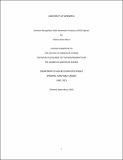| dc.contributor.author | Mouri, Fatima Islam | |
| dc.date.accessioned | 2023-08-22T19:18:36Z | |
| dc.date.available | 2023-08-22T19:18:36Z | |
| dc.date.issued | 2023-08-15 | |
| dc.identifier.citation | Mouri, Fatima Islam. Emotion Recognition with Asymmetry Features of EEG Signals; A thesis submitted to the Faculty of Graduate Studied in partial fulfillment of the requirements for the degree of Master of Science, Department of Applied Computer Science. Winnipeg, Manitoba, Canada: University of Winnipeg, June, 2023. DOI: 10.36939/ir.202308221412. | en_US |
| dc.identifier.uri | https://hdl.handle.net/10680/2102 | |
| dc.description.abstract | Currently the study of affective computing (AC) includes a focus on researching emotion regulation and recognition. Recent studies in this field have utilized deep learning architectures to enhance emotion recognition from EEG signals. An alternative approach to deep learning is to use feature engineering to extract relevant features to train supervised machine learning models. Current theories in the neuroscience field can guide this feature engineering process. Neuroscientists have suggested various models to clarify how emotions are processed. One of these models suggests that positive emotions are processed in the left hemisphere, while negative emotions are processed in the right hemisphere. This emotional processing model has inspired previous studies to propose asymmetrical features to predict emotions. However, none of these studies have statistically evaluated whether the inclusion of asymmetrical features could yield benefits such as increased accuracy or reduced training time. To address that direction, this research presents both statistical evaluations for emotion regulation and a comparable model for emotion recognition. The outcomes show that brain hemispheres and frequency bands participate differently in processing emotions and observed the presence of the two asymmetry emotion processing models but in different frequency ranges. Also, the results from this study imply that by using asymmetry EEG, emotion recognition approaches can use fewer features without significantly compromising performance. | en_US |
| dc.language.iso | en | en_US |
| dc.publisher | University of Winnipeg | en_US |
| dc.rights | info:eu-repo/semantics/openAccess | en_US |
| dc.subject | Ultrasonic encephalography | en_US |
| dc.subject | Brain hemisphere asymmetry | en_US |
| dc.subject | Affective Computing | en_US |
| dc.subject | Emotion recognition | en_US |
| dc.subject | Supervised machine learning | en_US |
| dc.subject | Interpretable predictive models | en_US |
| dc.title | Emotion Recognition with Asymmetry Features of EEG Signals | en_US |
| dc.type | Thesis | en_US |
| dc.description.degree | Master of Science in Applied Computer Science | en_US |
| dc.publisher.grantor | University of Winnipeg | en_US |
| dc.identifier.doi | 10.36939/ir.202308221412 | en_US |
| thesis.degree.discipline | Applied Computer Science | |
| thesis.degree.level | masters | |
| thesis.degree.name | Master of Science in Applied Computer Science | |
| thesis.degree.grantor | University of Winnipeg | |

